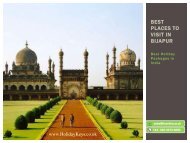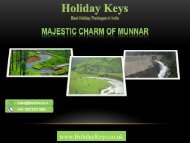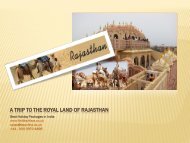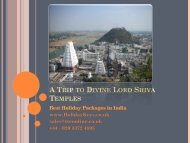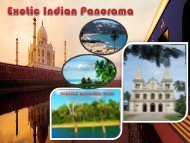Best Tourist Attraction Places in Gwalior - HolidayKeys.co.uk
Each and Every part of a country tells a story about its contribution to the country, whatever it is a small part or a big part, every member has its own importance in a family. India is also same; its every part has contributed to its history. “Gwalior” is one of them; it’s not a small city, now it’s a metropolitan city, and has its own historic background, located in Madhya Pradesh state, surrounded by rocky hills from all sides, on the north it has just formed the border of the Ganga–Yamuna Drainage Basin. The city is ruled by several historic northern kingdoms such as Maharaj Suraj Sen, the founder of the city, Naad dynasty of Pataliputra, Naga Dynasty, kushanas, Guptas, Kannauj of Gurar-Pratihara Dynasty, Kachwaha, Iltutmish, before Iltutmish Muhammad Ghori invaded the city and planned a mass destruction to capture the fort but unfortunately he failed by the brave efforts of Parihars. The rulers have remained their pages in history; they all contributed to in the history of the city through establishment some great structures. But the golden time was started from the Tomars Kingdom in 1375 by Raja Veer Singh; it was passed on to the Mughals, then to the Marathas in 1754 followed by the Scindias in the18th century.
Each and Every part of a country tells a story about its contribution to the country, whatever it is a small part or a big part, every member has its own importance in a family. India is also same; its every part has contributed to its history. “Gwalior” is one of them; it’s not a small city, now it’s a metropolitan city, and has its own historic background, located in Madhya Pradesh state, surrounded by rocky hills from all sides, on the north it has just formed the border of the Ganga–Yamuna Drainage Basin. The city is ruled by several historic northern kingdoms such as Maharaj Suraj Sen, the founder of the city, Naad dynasty of Pataliputra, Naga Dynasty, kushanas, Guptas, Kannauj of Gurar-Pratihara Dynasty, Kachwaha, Iltutmish, before Iltutmish Muhammad Ghori invaded the city and planned a mass destruction to capture the fort but unfortunately he failed by the brave efforts of Parihars. The rulers have remained their pages in history; they all contributed to in the history of the city through establishment some great structures. But the golden time was started from the Tomars Kingdom in 1375 by Raja Veer Singh; it was passed on to the Mughals, then to the Marathas in 1754 followed by the Scindias in the18th century.
Create successful ePaper yourself
Turn your PDF publications into a flip-book with our unique Google optimized e-Paper software.
www.<strong>HolidayKeys</strong>.<strong>co</strong>.<strong>uk</strong>
www.<strong>HolidayKeys</strong>.<strong>co</strong>.<strong>uk</strong><br />
Each and Every part of a <strong>co</strong>untry tells a story about its <strong>co</strong>ntribution to the <strong>co</strong>untry, whatever it is<br />
a small part or a big part, every member has its own importance <strong>in</strong> a family. India is also same;<br />
its every part has <strong>co</strong>ntributed to its history. <strong>Gwalior</strong> is one of them; its not a small city, now<br />
its a metropolitan city, and has its own historic background, located <strong>in</strong> Madhya Pradesh state,<br />
surrounded by rocky hills from all sides, on the north it has just formed the border of the Ganga–<br />
Yamuna Dra<strong>in</strong>age Bas<strong>in</strong>.<br />
The city is ruled by several historic northern<br />
k<strong>in</strong>gdoms such as Maharaj Suraj Sen, the founder of<br />
the city, Naad dynasty of Pataliputra, Naga Dynasty,<br />
kushanas, Guptas, Kannauj of Gurar-Pratihara<br />
Dynasty, Kachwaha, Iltutmish, before Iltutmish<br />
Muhammad Ghori <strong>in</strong>vaded the city and planned a<br />
mass destruction to capture the fort but unfortunately<br />
he failed by the brave efforts of Parihars. The rulers<br />
have rema<strong>in</strong>ed their pages <strong>in</strong> history; they all<br />
<strong>co</strong>ntributed to <strong>in</strong> the history of the city through<br />
establishment some great structures. But the golden<br />
time was started from the Tomars K<strong>in</strong>gdom <strong>in</strong> 1375<br />
by Raja Veer S<strong>in</strong>gh; it was passed on to the Mughals,<br />
then to the Marathas <strong>in</strong> 1754 followed by the Sc<strong>in</strong>dias<br />
<strong>in</strong> the18th century.
www.<strong>HolidayKeys</strong>.<strong>co</strong>.<strong>uk</strong><br />
Lets start your journey with <strong>Gwalior</strong> Fort from where the history starts and city owes its<br />
name. This fort takes birth from a local tradition, Suraj Sen, a pr<strong>in</strong>ce of gurjar – parihar clan of <strong>in</strong><br />
the 18th century, lost his way <strong>in</strong> the hunt<strong>in</strong>g while hunt<strong>in</strong>g. On a secluded hill, he met an old<br />
man, the sage Gwalipa, whose <strong>in</strong>fluence almost took him by surprise. When he asked for<br />
dr<strong>in</strong>k<strong>in</strong>g water, he was led to the pond, where the water hasnt only quenched his thirst but<br />
cured him of leprosy. In gratitude of heal<strong>in</strong>g from leprosy, the pr<strong>in</strong>ce wished to offer the sage to<br />
return someth<strong>in</strong>g to sage, and sage asked him to build a defensive wall on the hill to protect the<br />
other sages from the dangerous wild animals so that they cannot disturb the sages <strong>in</strong> Yagyas.<br />
Suraj Sen later build a Palace <strong>in</strong>side the fort, which was named after the sage <strong>Gwalior</strong> after the<br />
sage, eventually the city grows around the fort took the same name.
www.<strong>HolidayKeys</strong>.<strong>co</strong>.<strong>uk</strong><br />
The fort has and its premises are well ma<strong>in</strong>ta<strong>in</strong>ed and house many historic monuments<br />
<strong>in</strong>clud<strong>in</strong>g palaces, temples and water tanks. There are a number of palaces, <strong>in</strong>clud<strong>in</strong>g the Man<br />
mandir, the Gujari, the Jahangir, the Karan, and the Shah Jahan. It <strong>co</strong>vers an area of 3 kilometers<br />
and rises 35 feet, it rampart is built around the edge of the hill, <strong>co</strong>nnected by towers. It has two<br />
entrances; one is northeast side with a long access ramp and other on the southwest. The ma<strong>in</strong><br />
entrance is the ornate elephant gate. The other is Badalgarh gate.<br />
There are other palaces are built by several rulers like Man Mandir Palace built by Maharaja<br />
Man S<strong>in</strong>gh of Tomar Dynasty, Hathi Pol which leads to Man Mandir Palace, Gujari Mahal<br />
museum which was built by Raja Man S<strong>in</strong>gh for his wife Mrignayani, a Gurjar pr<strong>in</strong>cess, on<br />
demand that she wanted a separate Palace for herself, now this palace is <strong>co</strong>nverted to museum.
www.<strong>HolidayKeys</strong>.<strong>co</strong>.<strong>uk</strong><br />
There you will see rare artefacts at the museum <strong>in</strong>clude H<strong>in</strong>du and Ja<strong>in</strong> sculptures dated to 1st<br />
and 2nd centuries BC, you will see the m<strong>in</strong>iatures of Salabhanjika; terra<strong>co</strong>tta items and replicas of<br />
fres<strong>co</strong>es seen <strong>in</strong> the Bagh Caves. Karn Mahal, Vikram mahal, Chhatri of Bhim S<strong>in</strong>gh Rana are also<br />
rema<strong>in</strong> <strong>in</strong> the fort.<br />
There is a temple <strong>in</strong>side the fort, which was built<br />
<strong>in</strong> the 9th century, named as Sas-bahu Temple,<br />
you must be th<strong>in</strong>k<strong>in</strong>g that what k<strong>in</strong>d of temple it<br />
is on mother – <strong>in</strong> –law and daughter – <strong>in</strong> –law,<br />
but its not that. It takes a short form Sahastra<br />
Bahu which is a form of Lord Vishnu. These<br />
both temples are situated adjacent to each other<br />
and the large one is elaborately with beautiful<br />
carv<strong>in</strong>gs and sculptures. The roof of the larger<br />
temple is adorned with a marvelous lotus<br />
carv<strong>in</strong>g which is very fasc<strong>in</strong>at<strong>in</strong>g.<br />
These ancient temples display exceptional architectural brilliance and are a perfect dest<strong>in</strong>ation<br />
for pious people. It allures not only the devotees, but also the tourists with its artistic value.
www.<strong>HolidayKeys</strong>.<strong>co</strong>.<strong>uk</strong><br />
The Teli Ka Mandir is a huge structure <strong>in</strong> the city, this make itself dist<strong>in</strong>guished from the other<br />
architectures, its about 100 feet, and it is <strong>co</strong>mpletely different <strong>in</strong> architecture, it is made <strong>in</strong><br />
Dravidian and North Indian style. It is a Lord Vishnu. The temple bears a close resemblance to the<br />
temple of Prathihara Vishnu, and is filled with images of <strong>co</strong>iled serpents, passionate <strong>co</strong>uples, river<br />
goddesses, and a fly<strong>in</strong>g Garuda. It is one of the major tourist attractions.<br />
Ja<strong>in</strong> rock-cut sculptures also rema<strong>in</strong>s there, a series of cave rock out sculptures, excavated <strong>in</strong> the<br />
rock on all sides, number<strong>in</strong>g about nearly hundred. They were all excavated with<strong>in</strong> a short period<br />
of about thirty-three years, between 1441 and 1474. One of the <strong>co</strong>lossal figures is 57 ft high,<br />
taller than any other <strong>in</strong> northern India. There are also Ja<strong>in</strong> temples <strong>in</strong> the fort, which has all the<br />
26 Thiranthkars of Ja<strong>in</strong>ism.<br />
The Jai Vilas Mahal was built <strong>in</strong> 1874, as the residence of the Marathas – the Sc<strong>in</strong>dias, now it is<br />
turned to the museum. It is a heart of the city. It has all the antique and unique <strong>co</strong>llections of<br />
gadgets and <strong>co</strong>llection that is impossible to see anywhere else. It is the largest museum <strong>in</strong><br />
Madhya Pradesh and worlds largest chandeliers and it is a mixture of British and H<strong>in</strong>du<br />
architecture.<br />
There is the burial place of the Sc<strong>in</strong>dias, who ruled the city, is situated near the Achaleshwar<br />
temple named as Chatris of Sc<strong>in</strong>dias. The designated persons like Maharaja Madhavrao Sc<strong>in</strong>dia,<br />
Vijayaraje Sc<strong>in</strong>dia and His Highness Jivajirao Sc<strong>in</strong>dia were cremated here.
www.<strong>HolidayKeys</strong>.<strong>co</strong>.<strong>uk</strong>
www.<strong>HolidayKeys</strong>.<strong>co</strong>.<strong>uk</strong><br />
The city is the birthplace of the great musician Tansen who enlighten the lamps by his s<strong>in</strong>g<strong>in</strong>g;<br />
he was one of the N<strong>in</strong>e Gems of Akbar. His tomb is also located <strong>in</strong> the city, named as Tomb of<br />
Tansen.<br />
Rani Lakhshami Bai was died here to fight aga<strong>in</strong>st the Britishers, she was a famous freedom<br />
fighter of 1857, her statue with her horse is situated <strong>in</strong> Phoolbagh area, it is the place where she<br />
died dur<strong>in</strong>g a fight aga<strong>in</strong>st the British <strong>in</strong> 1858. It is also a burial place named as Samadhi of Rani<br />
Lakshmi Bai.<br />
There are also some tourist places Kuno National Park, Madhav National Park, Padavali and<br />
Mitavali, Sonagir, etc. This city has amaz<strong>in</strong>g architectural structure, which you will def<strong>in</strong>itely like<br />
to visit the best places <strong>in</strong> <strong>Gwalior</strong>.







